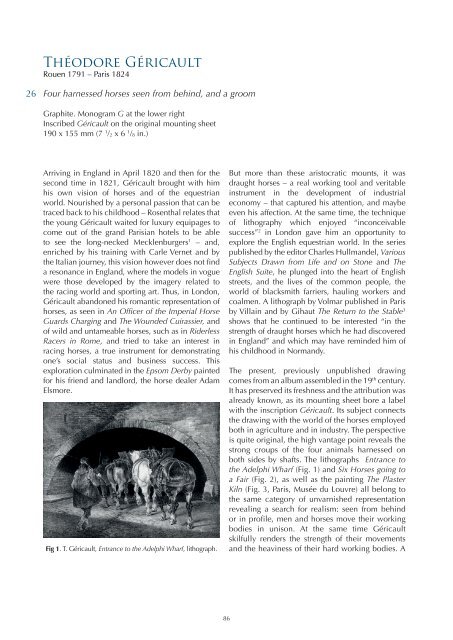Works on Paper 2019 - Jean Luc Baroni
- No tags were found...
You also want an ePaper? Increase the reach of your titles
YUMPU automatically turns print PDFs into web optimized ePapers that Google loves.
Théodore Géricault<br />
Rouen 1791 – Paris 1824<br />
26<br />
Four harnessed horses seen from behind, and a groom<br />
Graphite. M<strong>on</strong>ogram G at the lower right<br />
Inscribed Géricault <strong>on</strong> the original mounting sheet<br />
190 x 155 mm (7 1 /2 x 6 1 /8 in.)<br />
Arriving in England in April 1820 and then for the<br />
sec<strong>on</strong>d time in 1821, Géricault brought with him<br />
his own visi<strong>on</strong> of horses and of the equestrian<br />
world. Nourished by a pers<strong>on</strong>al passi<strong>on</strong> that can be<br />
traced back to his childhood – Rosenthal relates that<br />
the young Géricault waited for luxury equipages to<br />
come out of the grand Parisian hotels to be able<br />
to see the l<strong>on</strong>g-necked Mecklenburgers 1 – and,<br />
enriched by his training with Carle Vernet and by<br />
the Italian journey, this visi<strong>on</strong> however does not find<br />
a res<strong>on</strong>ance in England, where the models in vogue<br />
were those developed by the imagery related to<br />
the racing world and sporting art. Thus, in L<strong>on</strong>d<strong>on</strong>,<br />
Géricault aband<strong>on</strong>ed his romantic representati<strong>on</strong> of<br />
horses, as seen in An Officer of the Imperial Horse<br />
Guards Charging and The Wounded Cuirassier, and<br />
of wild and untameable horses, such as in Riderless<br />
Racers in Rome, and tried to take an interest in<br />
racing horses, a true instrument for dem<strong>on</strong>strating<br />
<strong>on</strong>e’s social status and business success. This<br />
explorati<strong>on</strong> culminated in the Epsom Derby painted<br />
for his friend and landlord, the horse dealer Adam<br />
Elsmore.<br />
Fig 1. T. Géricault, Entrance to the Adelphi Wharf, lithograph.<br />
But more than these aristocratic mounts, it was<br />
draught horses – a real working tool and veritable<br />
instrument in the development of industrial<br />
ec<strong>on</strong>omy – that captured his attenti<strong>on</strong>, and maybe<br />
even his affecti<strong>on</strong>. At the same time, the technique<br />
of lithography which enjoyed “inc<strong>on</strong>ceivable<br />
success” 2 in L<strong>on</strong>d<strong>on</strong> gave him an opportunity to<br />
explore the English equestrian world. In the series<br />
published by the editor Charles Hullmandel, Various<br />
Subjects Drawn from Life and <strong>on</strong> St<strong>on</strong>e and The<br />
English Suite, he plunged into the heart of English<br />
streets, and the lives of the comm<strong>on</strong> people, the<br />
world of blacksmith farriers, hauling workers and<br />
coalmen. A lithograph by Volmar published in Paris<br />
by Villain and by Gihaut The Return to the Stable 3<br />
shows that he c<strong>on</strong>tinued to be interested “in the<br />
strength of draught horses which he had discovered<br />
in England” and which may have reminded him of<br />
his childhood in Normandy.<br />
The present, previously unpublished drawing<br />
comes from an album assembled in the 19 th century.<br />
It has preserved its freshness and the attributi<strong>on</strong> was<br />
already known, as its mounting sheet bore a label<br />
with the inscripti<strong>on</strong> Géricault. Its subject c<strong>on</strong>nects<br />
the drawing with the world of the horses employed<br />
both in agriculture and in industry. The perspective<br />
is quite original, the high vantage point reveals the<br />
str<strong>on</strong>g croups of the four animals harnessed <strong>on</strong><br />
both sides by shafts. The lithographs Entrance to<br />
the Adelphi Wharf (Fig. 1) and Six Horses going to<br />
a Fair (Fig. 2), as well as the painting The Plaster<br />
Kiln (Fig. 3, Paris, Musée du Louvre) all bel<strong>on</strong>g to<br />
the same category of unvarnished representati<strong>on</strong><br />
revealing a search for realism: seen from behind<br />
or in profile, men and horses move their working<br />
bodies in unis<strong>on</strong>. At the same time Géricault<br />
skilfully renders the strength of their movements<br />
and the heaviness of their hard working bodies. A<br />
86
















